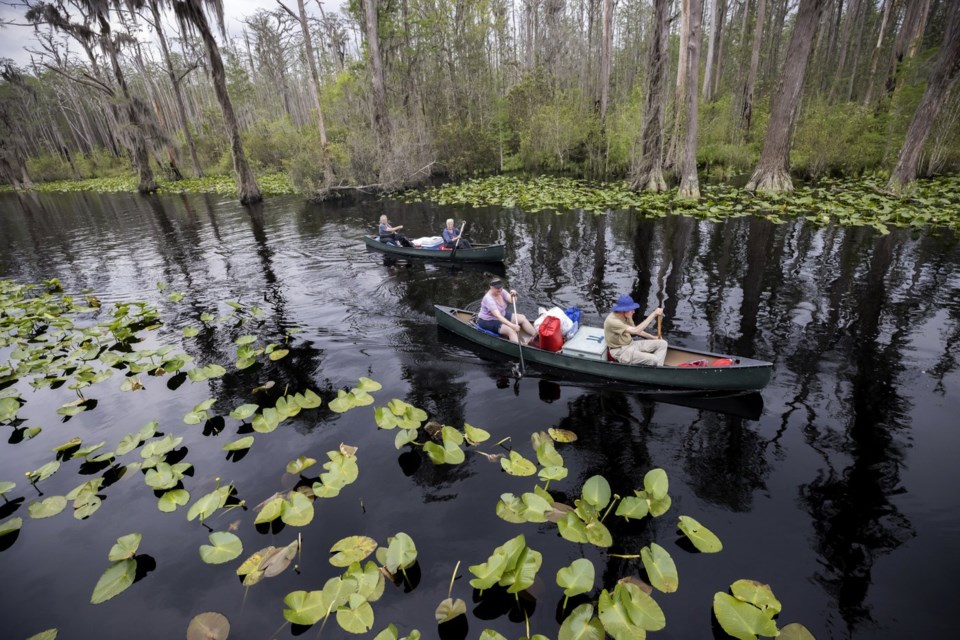SAVANNAH, Ga. (AP) — A federal agency proposed an expansion of the vast wildlife refuge on Friday, which could lead to a buyout offer for land intended for a private company's mining project that conservationists have fought for years.
The U.S. Fish and Wildlife Service said it’s considering adding 22,000 acres (8,900 hectares) along the boundaries of the Okefenokee National Wildlife Refuge, the largest federal refuge east of the Mississippi River.
The agency said its proposed expansion includes land owned by Twin Pines Minerals, which is on the cusp of obtaining state permits to mine titanium dioxide near the swamp’s southeastern edge.
Scientists have warned that mining near the Okefenokee’s bowl-like rim the swamp’s ability to hold water and increase the frequency of withering droughts. Interior Secretary Deb Haaland in 2022 declared that the proposed mine poses an to the fragile ecosystem at the Georgia-Florida line.
The Fish and Wildlife Service, which manages the refuge and is part of the Interior Department, said it will take public comments on the expansion proposal for the next 30 days.
“If adopted, the proposed minor boundary expansion would enable the Service to work with willing landowners to explore voluntary conservation actions, including potential acquisition, that would further protect the refuge’s globally significant freshwater wetland system and wildlife habitat,” the agency said in a news release.
The proposal comes as Twin Pines awaits final approval from Georgia environmental regulators of its mining project less than 3 miles (4.8 kilometers) from the refuge's current boundary. The company, which first applied for permits in 2019, has insisted that it can mine near the Okefenokee refuge without harming it.
The Georgia Environmental Protection Division issued draft permits for the project in February, after state regulators said their own analysis “concluded that water level in the swamp will be minimally impacted.” Final permits are still pending.
The Okefenokee refuge covers nearly 630 square miles (1,630 square kilometers) in southeast Georgia and is home to more than 400 animal species including alligators and bald eagles. The swamp’s wildlife, cypress forests and flooded prairies draw roughly 400,000 visitors each year, according to the Fish and Wildlife Service, which manages the refuge.
Conservationists who have fought the proposed mine applauded the federal agency's move to create an expanded buffer along the refuge's edge.
“Scientists say to protect what's inside the swamp, you have to protect what's on the outside,” said Rena Ann Peck of the Georgia River Network.
Josh Marks, an Atlanta environmental attorney and vocal critic of the mining project, called the proposed refuge expansion “a critical first step.”
“It’s the strongest representation to the state of Georgia that the federal government wants a permanent solution to this problem,” Marks said.
He called on Georgia Gov. Brian Kemp to "stop the issuance of the permit and join the federal government in permanently protecting Georgia’s greatest national treasure.”
A spokesperson for Twin Pines did not immediately respond to an email message seeking comment Friday.
Typically, the U.S. Army Corps of Engineers would also need to approve permits. But it lost that authority over the Georgia project in 2020 because of under then-President Donald Trump.
The U.S. Fish and Wildlife Service sought to reclaim some federal oversight of the project in January, when the agency asserted legal rights to waters that feed the Okefenokee refuge.
Twin Pines has applied to withdraw more than 1.4 million gallon (5.3 million litres) daily for its Georgia mine. The agency says federal law prohibits the project from diverting water from the refuge in quantities that would harm its function as a protective habitat for native animal and plant species.
Russ Bynum, The Associated Press



